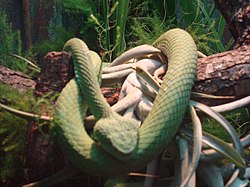| Image | Species [5] | Taxon author [5] | Common name [3] | Geographic range [1] |
|---|
 | B. aurifer | (Salvin, 1860) | yellow-blotched palm-pitviper | Mexico, in the mountains of eastern Chiapas, in northern Guatemala. Occurs in cloud forest at 1200–2300 m altitude. |
 | B. bicolor | (Boucourt, 1868) | Guatemalan palm-pitviper | The Pacific slope of southeastern Chiapas in Mexico, eastward to south-central Guatemala. Also known from several locations in Honduras, including the southern part of the Sierra del Merendón and Cerro Santa Bárbara. Occurs in cloud forests at 500–2000 m altitude. |
 | B. guifarroi | Townsend, Medina-Flores,
Wilson, Jadin & Austin, 2013 [8] | Guifarro's palm-pitviper | Honduras at 1015–1450 m altitude. "Found in the western portion of Cordillera Nombre de Dios, Department of Atlantida, Honduras." [6] |
 | B. hussaini | Arteaga et al. 2024 [9] | Hussain's eyelash pitviper | |
 | B. khwargi | Arteaga et al. 2024 [9] | Khwarg’s eyelash pitviper | |
 | B. klebbai | Arteaga et al. 2024 [9] | Klebba's eyelash pitviper | |
 | B. lateralis | W. Peters, 1862 | side-striped palm-pitviper | The mountains of Costa Rica and western Panama, including the Cordillera de Tilarán, the Cordillera Central and the Cordillera de Talamanca to the provinces of Chiriquí Province and Veraguas. Occurs at 850–980 m altitude. |
 | B. marchi | (Barbour & Loveridge, 1929) | Honduran palm-pitviper | The Atlantic versant of northwestern Honduras and eastern Guatemala. Occurs in mesic forest at elevations of 500–1500 m altitude. |
 | B. nigroadspersus | Steindachner, 1870 [9] | Central American eyelash pitviper | |
 | B. nigroviridis T | W. Peters, 1859 | black-speckled palm-pitviper | The mountains of Costa Rica and Panama. Also found in the cloud forests of the Cordillera Central and the Cordillera de Talamanca at 1150–2400 m altitude. |
 | B. nitidus | Günther, 1859 [9] | Ecuadorian eyelash pitviper | |
 | B. nubestris | Doan, Mason, Castoe, Sasa & Parkinson, 2016 | Talamancan palm-pitviper | Costa Rica. San Isidro de El General, Province of San José at approximately 3000 m altitude. |
 | B. rahimi | Arteaga et al. 2024 [9] | Rahim's eyelash pitviper | |
 | B. rasikusumorum | Arteaga et al. 2024 [9] | Shah's eyelash pitviper | |
 | B. rowleyi | (Bogert, 1968) | Mexican palm-pitviper | Mexico in southeastern Oaxaca and northern Chiapas. Occurs in cloud forests at 1500–1830 m altitude. |
 | B. schlegelii | (Berthold, 1846) | highland eyelash pitviper, Schlegel’s eyelash pitviper | From southern Mexico (northern Chiapas), southeastward on the Atlantic slope and lowlands through Central America to northern South America in Colombia and Venezuela. Also found on the Pacific versant and lowlands in parts of Costa Rica, Panama, Colombia, Ecuador and Peru. Occurs in mesic forest at elevations almost from sea level to 2640 m altitude. |
 | B. supraciliaris | (Taylor, 1954) | blotched eyelash pitviper | Only found in a mountainous area in southwestern Costa Rica. Occurs in lower montane wet forest and cloud forest at elevations from 800 m to 1,700 m. [10] |
 | B. thalassinus | Campbell & E.N. Smith, 2000 | Merendon palm-pitviper | Guatemala, Honduras at 1370–1750 m altitude. |
 | B. torvus | Posada-Arango, 1889 [9] | Birri eyelash pitviper | |




















